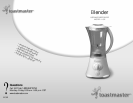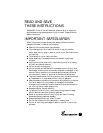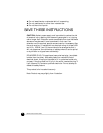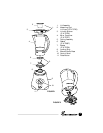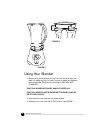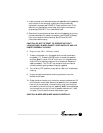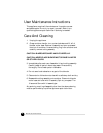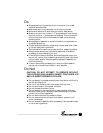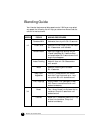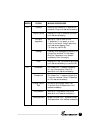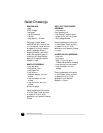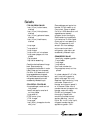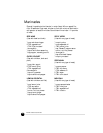
7.
Do
◆ Always place liquid ingredients into the container first, unless
recipe directs otherwise.
◆ Most foods require only seconds, not minutes, to process.
◆ Blend small amounts of solid food at a time for best results.
◆ Break or cut food into uniform 1”-2” size pieces and hard fibrous
food into uniform
1
⁄
2
” pieces before processing. This will allow the
food to drop down around the blades for faster, more thorough
blending action.
◆ Always place lid assembly on container before turning blender on
to prevent splattering.
◆ To add foods while blender is operating, remove small clear insert
on lid and slowly add ingredients.
◆ The removable lid insert may be used as a 2 oz. measuring device.
◆ Always remove bones, pits, hard shells, seeds, and cores before
processing to avoid damaging the unit.
◆ If food sticks to sides of container and blending action stops, turn
the unit off, remove the lid assembly and carefully push food down
using a rubber spatula. Remove spatula, replace lid assembly and
continue blending.
◆ If motor labors while processing, turn knob to higher speed or
remove part of contents and blend in small batches.
Do Not
CAUTION: DO NOT ATTEMPT TO OPERATE WITHOUT
THE LOCKING RING, BLADES, GASKET, CONTAINER, LID
AND LID INSERT PROPERLY IN PLACE.
◆ Do not attempt to process extremely hard food which is difficult to
cut with a kitchen knife.
◆ Do not fill the container with food above the 5 cup level.
◆ Do not store foods in the blender container.
◆ Do not process ice without liquids.
◆ Do not attempt to use the blender to mash potatoes, whip egg
whites or cream, grind raw meat, knead heavy doughs, or extract
juices from fruits and vegetables.
◆ Do not use the blender to process hot foods.
◆ Do not remove blender container from base or replace it until
motor has stopped.
◆ Do not remove lid assembly while processing. Use removable insert
on lid to add ingredients.



